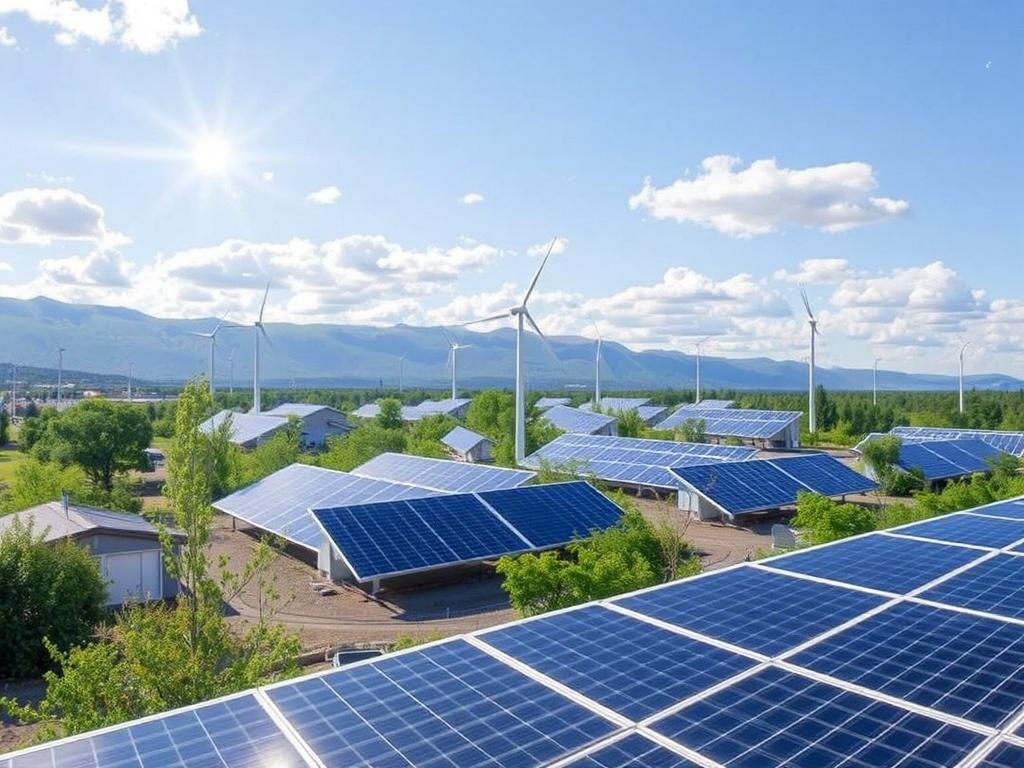- What Are Corporate PPAs?
- Why Corporations Choose PPAs
- Types of Corporate PPAs: Onsite, Offsite, Virtual
- The How-To of Corporate PPAs: Steps Companies Take
- 1. Define Energy Goals and Procurement Strategy
- 2. Market Assessment and Partner Identification
- 3. Contract Negotiation
- 4. Regulatory and Legal Review
- 5. Execution and Ongoing Management
- Financial and Environmental Benefits of Corporate PPAs
- Price Stability
- Greenhouse Gas Emission Reductions
- Additional Environmental Attributes
- Challenges and Risks in Corporate PPAs
- Contract Complexity
- Market and Price Risks
- Regulatory Hurdles
- Credit and Counterparty Risks
- Examples of Corporate Leaders Using PPAs
- The Future of Corporate PPAs: Trends and Innovations
- Emergence of Aggregated PPAs
- Innovative Contract Structures
- Expansion into New Geographies
- Integration with ESG and Reporting Frameworks
- Comparison of Corporate PPA Pricing Models
- Key Stakeholders in a Corporate PPA
- Conclusion
In recent years, corporate Power Purchase Agreements (PPAs) have become a powerful tool for companies aiming to secure clean energy while supporting the transition to a low-carbon economy. But what exactly are corporate PPAs, and why are so many big businesses turning to them to meet their sustainability goals? From tech giants powering data centers with renewable energy to manufacturing firms reducing their carbon footprint through green contracts, corporate PPAs are redefining how companies buy electricity.
This article dives deep into the mechanics of corporate PPAs, explores their benefits and challenges, and shows why they are becoming the go-to solution for businesses intent on buying clean power. We’ll break down the types of PPAs, explain key financial and legal structures, and offer insight into the growing market shaping the future of energy procurement. Whether you’re a sustainability enthusiast, a business leader, or simply curious, read on to discover how big business buys clean power in today’s evolving landscape.
What Are Corporate PPAs?
At its core, a corporate Power Purchase Agreement is a contract between a company and a power generator to purchase electricity at a predetermined price for a defined term. These agreements allow companies to directly buy clean power from renewable energy projects like solar farms or wind parks, bypassing traditional utilities or energy markets.
Unlike typical utility contracts where electricity is bundled with distribution and various fees, corporate PPAs give businesses a direct link to the renewable energy source, offering greater price predictability and environmental benefits. For many companies looking to hit ambitious sustainability targets, corporate PPAs represent a strategic commitment to clean power procurement.
Why Corporations Choose PPAs
Businesses pursue corporate PPAs for several compelling reasons:
- Cost Savings: PPAs lock in energy prices for years, shielding companies from volatile fossil fuel markets and utility rate hikes.
- Environmental Impact: PPAs enable large-scale sourcing of renewable energy, helping companies reduce scope 2 greenhouse gas emissions significantly.
- Brand and Stakeholder Value: Sustainability-led procurement attracts customers, investors, and improves corporate social responsibility profiles.
- Energy Security: Through PPAs, companies can diversify energy sources and gain more control over their electricity supply.
Types of Corporate PPAs: Onsite, Offsite, Virtual
Corporate PPAs come in different flavors, primarily categorized by the location and nature of the energy transaction:
| Type of PPA | Description | Key Benefits | Challenges |
|---|---|---|---|
| Onsite PPA | Power generated and consumed at the company’s site, such as solar panels on rooftops. | Direct usage of renewable energy, minimal transmission losses, visible sustainability action. | Limited scalability, upfront infrastructure costs, site suitability constraints. |
| Offsite PPA | Power produced at a remote renewable facility, transmitted through the grid to the company. | Access to larger projects and cheaper renewable resources, scalability. | Complex contracts, regulatory dependencies, less direct control over power delivery. |
| Virtual (or Financial) PPA | A financial contract settling the price difference between market electricity price and fixed PPA price, without physical power delivery. | Enables companies in regions where direct renewable procurement is difficult, financial hedge benefits. | Requires energy market expertise, risk of market price fluctuations. |
Each type of corporate PPA has unique advantages and suits different company profiles and objectives. Choosing the right model requires aligning business needs with project characteristics and regulatory conditions.
The How-To of Corporate PPAs: Steps Companies Take
Engaging in a corporate PPA is a multi-step process that requires careful planning and collaboration among various stakeholders. Here is a high-level overview of the typical steps involved:
1. Define Energy Goals and Procurement Strategy
Companies begin by setting clear renewable energy targets aligned with broader sustainability or net zero plans. This includes determining the volume of clean power they aim to procure and preferred timelines.
2. Market Assessment and Partner Identification
Next, businesses assess the renewable energy market landscape, identifying suitable developers or power producers who have projects matching their size, location, and technology preferences.
3. Contract Negotiation
Detailed negotiations address pricing mechanisms, contract length, risk allocation, and performance guarantees. Many corporate PPAs span 10 to 20 years to secure stable pricing.
4. Regulatory and Legal Review
Since corporate PPAs are shaped by local energy regulations, thorough legal analysis ensures compliance. This step also tackles grid interconnection, environmental certificates (like Renewable Energy Certificates or RECs), and tax implications.
5. Execution and Ongoing Management
Upon contract signing, companies and producers work to finalize interconnection, monitor generation and delivery, and account for renewable attributes. Ongoing reporting supports both compliance and transparency with stakeholders.
Financial and Environmental Benefits of Corporate PPAs

One of the most compelling reasons companies pursue corporate PPAs is the blend of financial predictability with environmental leadership.
Price Stability
Traditional electricity costs fluctuate due to fuel price changes and market dynamics. Corporate PPAs typically fix electricity prices or include a predictable escalation, enabling companies to budget energy expenses with confidence.
Greenhouse Gas Emission Reductions
By directly contracting renewable energy, companies reduce their scope 2 emissions—the indirect emissions from purchased electricity. This is vital for companies reporting sustainability metrics and achieving carbon neutrality.
Additional Environmental Attributes
Many corporate PPAs include Renewable Energy Certificates (RECs), which verify the generation of clean power and its environmental benefits. Owning RECs strengthens a company’s green credentials.
Challenges and Risks in Corporate PPAs
Despite the benefits, corporate PPAs come with several challenges companies must navigate.
Contract Complexity
PPAs can be complex legal documents with nuanced financial terms, requiring specialized expertise to negotiate and manage.
Market and Price Risks
Especially with virtual PPAs, companies may face risks if wholesale market prices diverge substantially from PPA prices, potentially affecting financial outcomes.
Regulatory Hurdles
Energy regulations vary widely by region and can affect the feasibility, structure, and accounting treatment of corporate PPAs. Changing policies may also inject uncertainty.
Credit and Counterparty Risks
Companies need to assess developer financial strength and project completion risks to avoid contract breaches or delivery shortfalls.
Examples of Corporate Leaders Using PPAs
Many of the world’s largest companies are pioneers in the corporate PPA space, demonstrating the model’s scalability and appeal.
- Google: As one of the largest corporate buyers of renewable energy, Google has signed dozens of PPAs globally, powering data centers and operations with wind and solar.
- Amazon: Amazon actively purchases renewable energy through PPAs to meet its powering ambitions and reduce carbon emissions from logistics and cloud services.
- Microsoft: Microsoft has inked multiple PPAs for wind and solar projects around the world, supporting its goal to be carbon negative by 2030.
- IKEA: Through long-term offsite PPAs, IKEA secures clean power for retail locations and manufacturing, contributing to its climate positive strategy.
These companies set a precedent, showing how corporate PPAs can support ambitious sustainability and business strategies simultaneously.
The Future of Corporate PPAs: Trends and Innovations

As the corporate renewable energy market matures, several exciting trends are shaping the future of corporate PPAs.
Emergence of Aggregated PPAs
Smaller companies are increasingly banding together through aggregated or pooled PPAs to tap into renewable markets previously accessible only to large enterprises.
Innovative Contract Structures
Contracts that include hybrid models (combining storage or green hydrogen) and shorter duration agreements are gaining traction, providing flexibility.
Expansion into New Geographies
Regions like Asia-Pacific, Latin America, and Africa are seeing rising corporate PPA activity as renewable energy markets develop and regulatory frameworks improve.
Integration with ESG and Reporting Frameworks
Corporate PPAs are becoming integral to Environmental, Social, and Governance (ESG) reporting, making transparent renewable procurement a must-have for global investors and stakeholders.
Comparison of Corporate PPA Pricing Models
Understanding the pricing models within corporate PPAs helps companies customize deals based on risk tolerance and market conditions. Here’s a simple comparison:
| Pricing Model | Description | Advantages | Risks |
|---|---|---|---|
| Fixed Price | Company pays a set price per megawatt-hour (MWh) regardless of market changes. | Budget certainty, straightforward accounting. | May overpay if market prices drop. |
| Floor Price / Indexed | Price varies with market but doesn’t go below a certain floor price. | Some protection against market dips, more flexible. | Less predictable expenses. |
| Market Price with Collar | Price tied to market within a price band (collar). | Balances risk and reward, adaptive to market. | Potential price swings within collar limits. |
Choosing the right pricing structure is critical to managing financial exposure while achieving long-term renewable energy goals.
Key Stakeholders in a Corporate PPA

Understanding who is involved in a corporate PPA helps clarify roles and responsibilities. The main players include:
- The Corporate Buyer: The company seeking to purchase renewable energy to meet sustainability or operational goals.
- Renewable Energy Developer: The entity that builds, owns, and operates the renewable energy project.
- Offtaker or Aggregator: Sometimes a third party manages the PPA, particularly in virtual or pooled PPA structures.
- Utility or Grid Operator: Facilitates energy transmission and often issues environmental certificates.
- Legal and Financial Advisors: Provide expertise to structure, negotiate, and manage risks associated with the PPA.
Clear communication among these stakeholders is essential for successful corporate PPA implementation.
Conclusion
Corporate PPAs have emerged as a game-changing innovation for big businesses eager to buy clean power while gaining economic and environmental advantages. By directly contracting renewable energy, companies secure cost-effective, predictable, and sustainable electricity supply that aligns with their climate commitments and operational strategies. While challenges exist—ranging from contractual complexities to regulatory hurdles—the rapidly evolving market and expanding experience base continue to lower entry barriers. As more companies across sectors adopt corporate PPAs, this procurement model is set to play a central role in accelerating the global energy transition. Whether through onsite solar installations, large-scale offsite wind farms, or sophisticated virtual agreements, corporate PPAs are empowering businesses to lead the charge toward a cleaner, greener future.
Как вам статья?







